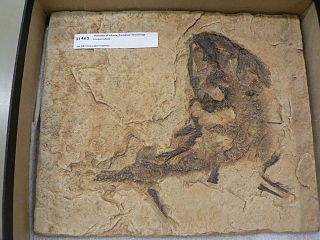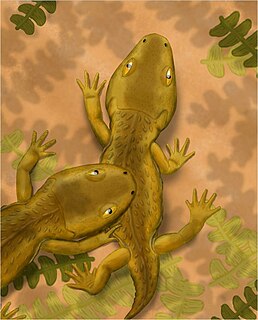 W
WThe Amphibamidae are an extinct family of dissorophoid temnospondyls known from Late Carboniferous-Early Permian strata in the United States.
 W
WAmphibamus is a genus of amphibamid temnospondyl amphibians from the Carboniferous of North America. This animal is considered to have been close to the ancestry of modern amphibians. Its length was about 20 cm.
 W
WEoscopus is an extinct genus of dissorophoidean euskelian temnospondyl in the family Micropholidae. It is known from Hamilton Quarry, a Late Carboniferous lagerstätte near Hamilton, Kansas.
 W
WGerobatrachus is an extinct genus of amphibamid temnospondyl that lived in the Early Permian, approximately 290 million years ago (Ma), in the area that is now Baylor County, Texas. When it was first described in 2008, Gerobatrachus was announced to be the closest relative of Batrachia, the group that includes modern frogs and salamanders. It possesses a mixture of characteristics from both groups, including a large frog-like head and a salamander-like tail. These features have led to it being dubbed a frogamander by the press. Some more recent studies place Gerobatrachus as the closest relative of Lissamphibia, the group that contains all modern amphibians including frogs, salamanders, and caecilians, or place modern amphibians far from Gerobatrachus within a group called Lepospondyli.
 W
WMicropholis is an extinct genus of dissorophoid temnospondyl. Fossils have been found from the Lystrosaurus Assemblage Zone of the Karoo Basin in South Africa and are dated to the Induan. Fossils have also been found from the lower Fremouw of Antarctica.Micropholis is the only post-Permian dissorophoid and the only dissorophoid in what is presently the southern hemisphere and what would have been termed Gondwana during the amalgamation of Pangea.
 W
WPlatyrhinops is an extinct genus amphibamid temnospondyl from the Late Carboniferous of Ohio and the Czech Republic. It is known from many partial skeletons from the Linton site in Saline Township, Ohio and at least 6 partial specimens from the Nýřany site from the Nýřany Member of the Kladno Formation in the Czech Republic.
 W
WRubeostratilia is an extinct genus of amphibamiform temnospondyl from the early Permian of Texas. It is known from a single skull. This genus was named by Hélène Bourget and Jason S. Anderson in 2011, and the type species is Rubeostratilia texensis. The genus name comes from the Latin translation of 'redbeds' in reference to the Texas redbeds that produced both the holotype and many other early Permian fossils. The species name is for the state of Texas. The holotype and only known specimen was collected in 1941 from the Nocona Formation exposures in Clay County by a Works Projects Administration project that was transferred to the Field Museum of Natural History through an interinstitutional exchange with the Texas Memorial Museum.